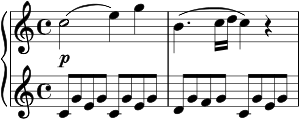Alberti bass
Alberti bass is a particular kind of accompaniment figure in music, often used in the Classical era, and sometimes the Romantic era. It was named after Domenico Alberti (1710–1740/46), who used it extensively, although he was not the first to use it.[5]
Alberti bass — the accompaniment figure based on broken chords and used in many sonatinas and sonatas; named after Domenico Alberti[6]
This style of L[eft]H[and] accompaniment gets its name from the 18th Century Italian composer, Domenico Alberti, who used it in many of his compositions. It was also used by Haydn, Mozart, Clementi and Beethoven, along with many other composers of the Classical period.[1]
A bass consisting of a succession of broken chords (arpeggios) of an unusual kind. Domenico Alberti, a gifted Venetian amateur who was born during the early part of the Eighteenth Century and died about 1740, is credited with the invention which bears his name. His cembalo music abounds in this style of accompaniment.[7]



Alberti bass is a kind of broken chord or arpeggiated accompaniment, where the notes of the chord are presented in the order lowest, highest, middle, highest. This pattern is then repeated several times throughout the music.[5] The broken chord pattern helps to create a smooth, sustained, flowing sound on the piano. "Chords of harmony broken up into short patterns. Steady bass patterns in orchestral music which give the rhythmic drive to Classical music, compensating for the energetic drive of the Baroque basso continuo line."[8]
Alberti bass is usually found in the left hand of pieces for keyboard instruments, especially for Mozart's piano pieces. However, it is also found in pieces for other instruments. It has been described as, "a true tolerable monotony,"[9] and as, "perhaps the most overworked fixture of eighteenth-century music."[10]
Well-known examples of Alberti bass include the beginning of Mozart's Piano Sonata, K 545.[lower-alpha 1] A famous example from 20th-century American popular music is the rhythm guitar part of the 1962 "surf rock" standard "Pipeline", by The Chantays.[12][13] Alberti bass is also used in the ending theme of Nintendo's Super Mario Bros. 2. [14][15]
References
- Palmer, Willard A.; Manus, Morton; and Lethco, Amanda Vick (2005). Alfred's Basic Adult Piano Course - Theory Book 3, p.12. Alfred Music. ISBN 9781457407482.
- Magrath, Jane (1988). Masterwork Practice & Performance, Level 3, p.40. Alfred Music. ISBN 9781457410819.
- Goldman, Richard Franko (1965). Harmony in Western Music, p.20-1 & 174. Barrie & Jenkins. ISBN 0-214-66680-8. "Examples of the Alberti bass...will be found...in the well-known C-major Sonata of Mozart (K. 545)."
- Benward, Bruce and Saker, Marylin (2009). Music in Theory and Practice, Vol. II, p.122-3. McGraw Hill. 8th edition. ISBN 978-0-07-310188-0.
- "Alberti Bass." Baker's Student Encyclopedia of Music. Ed. Laura Kuhn. Schirmer-Thomson Gale, 1999. ISBN 9780028654157.
- Magrath (1988). "Glossary", p.7.
- Andrews, George Whitfield (1910). The American History and Encyclopedia of Music, Vol. 1, p.21. I. Squire. William Lines Hubbard, ed. [ISBN unspecified].
- Hurry, Pam; Phillips, Mark; and Richards, Mark (2001). Heinemann Advanced Music, p.48. Heinemann. ISBN 9780435812584.
- Aschenbrenner, L. (2012). The Concept of Coherence in Art, p.200. Springer Science & Business Media. ISBN 9789400953277.
- Bernstein, Leonard (2007). The Infinite Variety of Music, p.51. Amadeus Press. ISBN 9781574674026. "But over and over again we can find Mozart using this figuration in such a way that it is transformed by the sheer beauty of his melodic invention above it."
- Rink, John (1984). Musical Performance: A Guide to Understanding. Cambridge University Press. p. 40. ISBN 9780521788625.
The first two bars of Mozart's Piano Sonata in C major K. 545... The passage consists of an Alberti-bass accompaniment supporting...[a] melody.
- Overly, Mike (March 25, 2015). "Surfin’ With Mozart", 12ToneMusic.WordPress.com. Accessed: 21 July 2019.
- Abjorensen, Norman (2017). Basslines with broken chords are also important in Boogie Woogie piano music. For instance Yancey Special by Meade Lux Lewis uses a typical Alberti bass. id=6ZyrDgAAQBAJ&pg=PA93&dq=the+chantays+pipeline+%22alberti+bass%22&hl=en&sa=X&ved=0ahUKEwjhr5mvl8fjAhUOB3wKHeMFA4MQ6AEIKjAA#v=onepage&q=the%20chantays%20pipeline%20%22alberti%20bass%22&f=false Historical Dictionary of Popular Music, p.93. Rowman & Littlefield. ISBN 9781538102152.
- "Ending"
- "Ending Theme - Super Mario Bros. 2"

